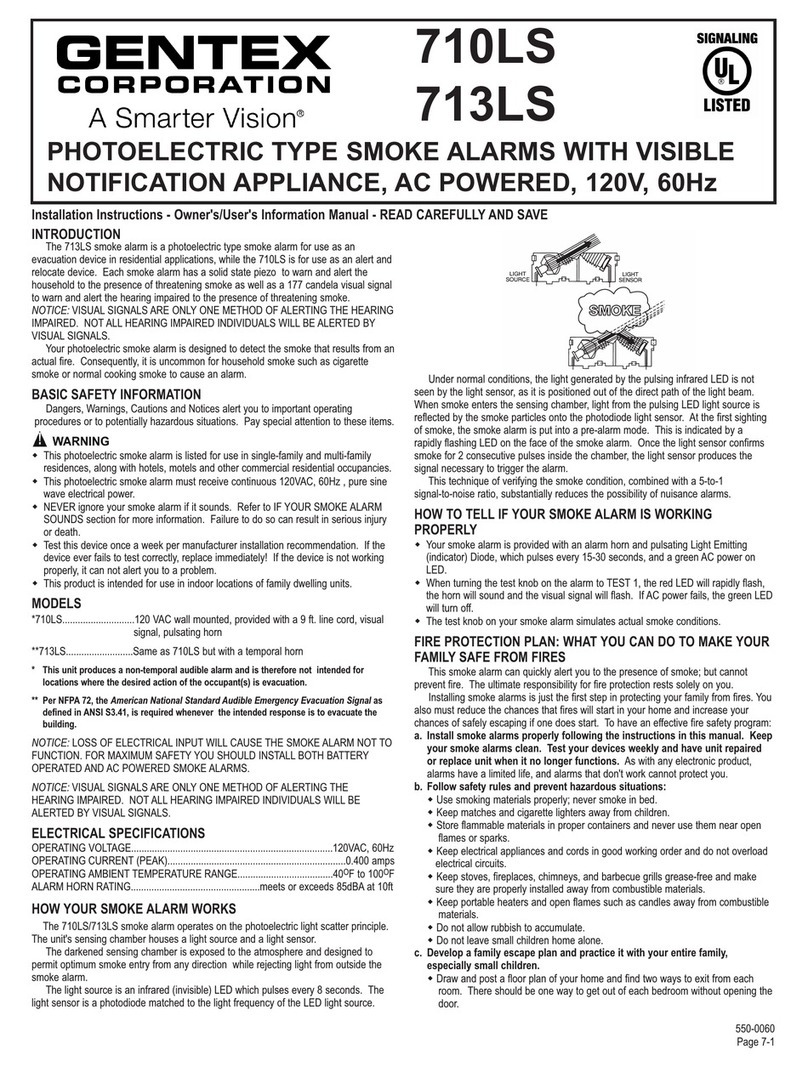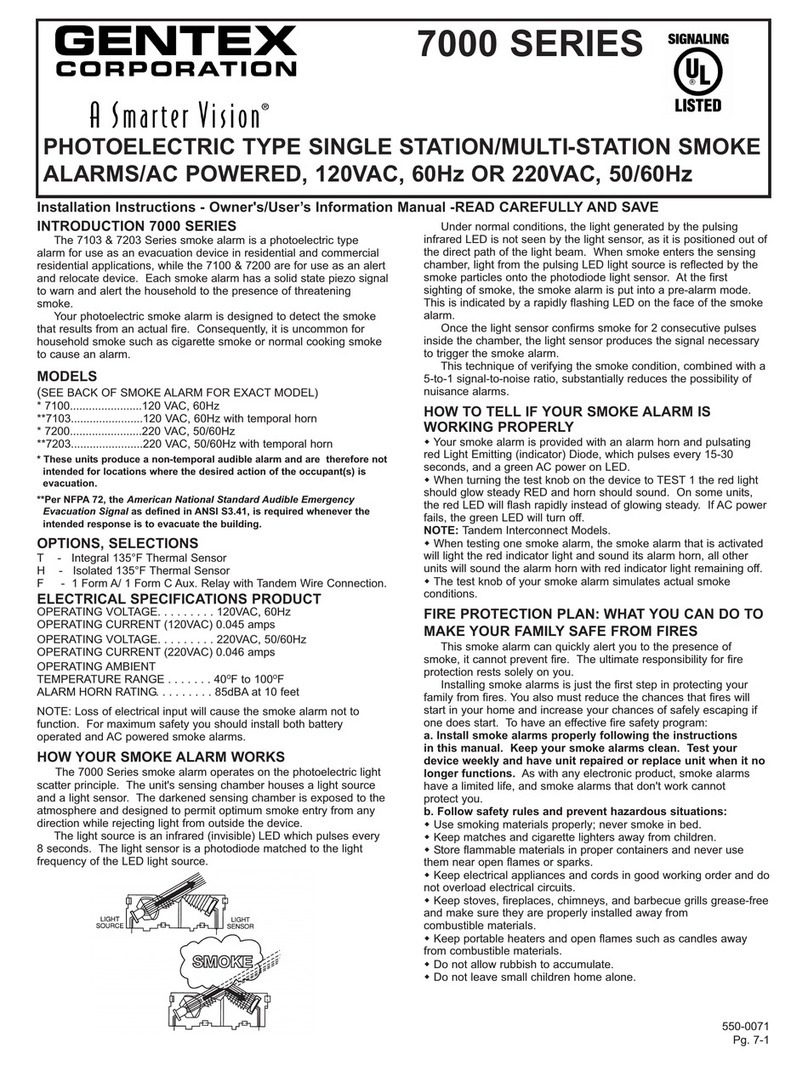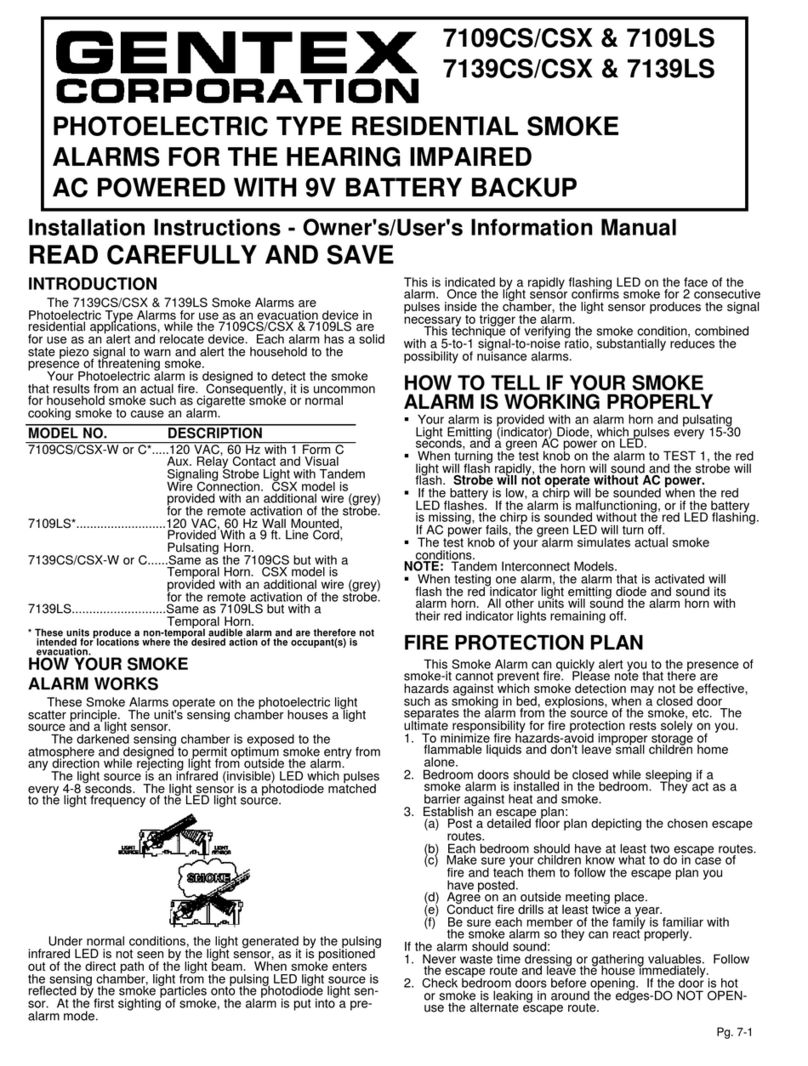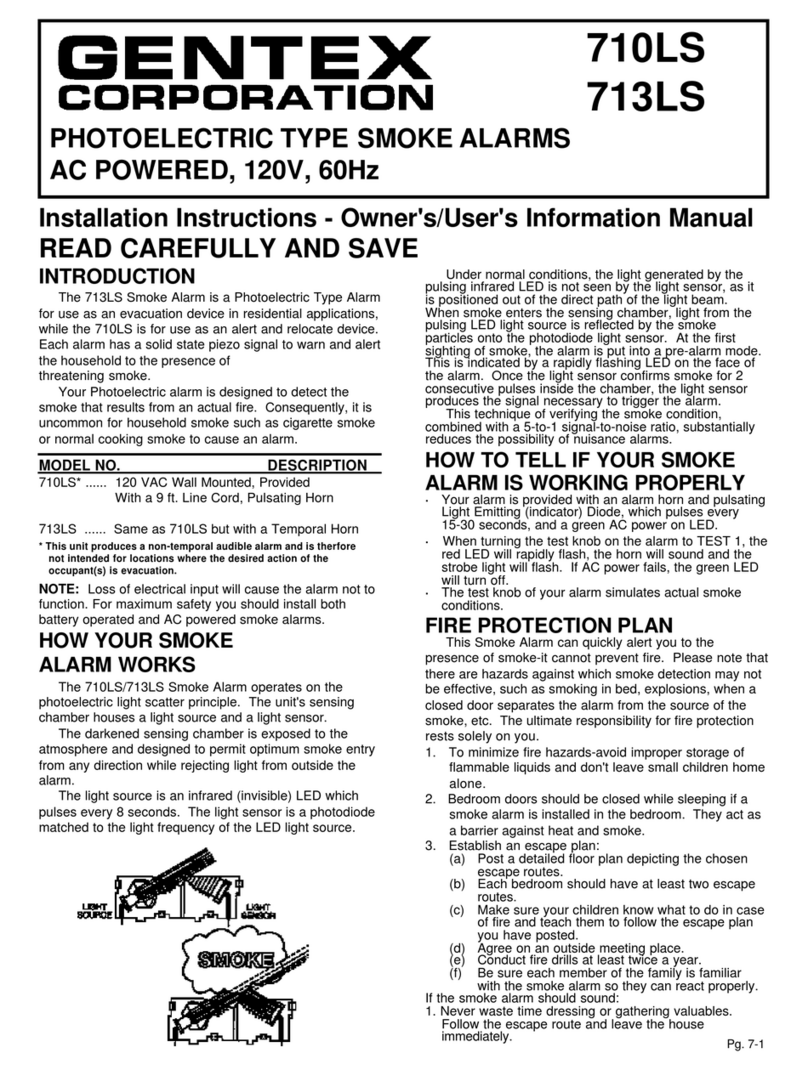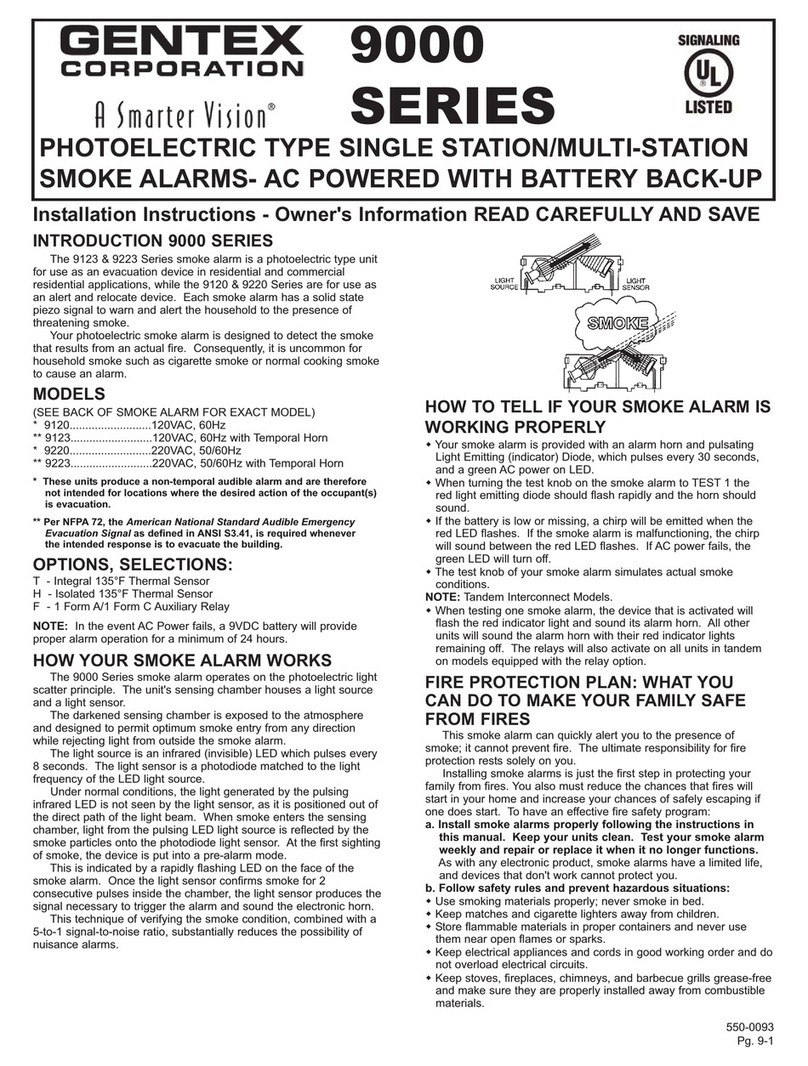
3. When powering up smoke alarms in a tandem installation and
all the smoke alarms sound immediately, inspect all smoke
alarms for a flashing red LED. These will be the trouble units.
4. To check for proper smoke entry into your smoke alarm's
sensing chamber, Gentex recommends using the ome
Safeguard Smoke Alarm spray or C EKKIT® SMOKE Detector
Tester from SDI. This test should be performed once a year and
should be sprayed with smoke alarm spray from a distance no
closer than 12 inches from the smoke alarm.
MAI TE A CE
After your smoke alarm has been in operation for a period of time
or if it was installed prior to the completion of all building
construction, your device may have become more sensitive due to
dirt build-up in the smoke alarm's optic sensing chamber which could
cause nuisance alarms or activation from small amounts of smoke
build-up.
If this should occur, following this simple washing procedure will
restore your smoke alarm back to its original condition.
For further information, regarding frequency of cleaning and test-
ing, refer to NFPA 72, NFPA, Batterymarch Park, Quincy, MA 02269.
NOTICE: Failure to follow full cleaning instructions could result
in damage to this smoke alarm. DO OT remove all smoke
alarms at the same time for cleaning.
1. Turn off electrical power to the smoke alarm.
2. Rotate smoke alarm counter-clockwise to remove it from its
mounting plate. OTE: If anti-tamper pins have been installed,
they must be removed before rotating smoke alarm from
mounting plate.
3. Unplug the connector from the back of the smoke alarm. Do not
remove the wire connection; leave the connector for your
replacement smoke alarm. Do not open smoke alarm cover.
Doing so, voids product warranty.
4. Select three (3) standard size wash buckets and fill them each
with one gallon of normal tap water (distilled or de-ionized
treated water is recommended as a final rinse if water is
extremely hard in your area).
5. Add 1/8 cup of Ivory dishwashing liquid to the first bucket of water
and allow it to mix thoroughly, then place one dirty smoke alarm
into the soap water mixture until it becomes completely covered or
submerged. NOTE: If the smoke alarms are exceptionally dirty,
you may wish to first wipe off any excess dirt before washing
the unit so as not to dirty the wash water too quickly.
DO OT open smoke alarm for cleaning. IF SMOKE ALARM IS
OPE ED, PRODUCT WARRA TY BECOMES VOID.
NOTICE: ONLY IVORY DIS WAS ING LIQUID IS TO BE USED.
OT ER BRANDS ARE NOT RECOMMENDED AND MAY CAUSE
YOUR SMOKE ALARM TO MALFUNCTION.
6. Allow smoke alarm to soak for approximately 10 minutes (longer if
extremely dirty). Then agitate for 5 or 10 seconds to flush out any
remaining dirt left inside smoke alarm's housing.
7. Remove smoke alarm from wash water and transfer directly to
one of the first rinse buckets containing clear water. Again, allow
smoke alarm to become completely submerged, agitate once
more for 5 or 10 seconds to remove soap residue.
8. Finally, transfer smoke alarm to your second and final rinse
bucket, repeating method found in Step 7, then remove smoke
alarm to a clean dry area for a period of 48 hours to allow it to
thoroughly dry.
NOTICE: SMOKE ALARMS ARE TO BE AIR DRIED O LY. DO
OT PLACE SMOKE ALARM I OVE , MICROWAVE OR USE A
HOT AIR BLOWER TO ACCELERATE DRYI G TIME. THIS
COULD RESULT I DAMAGE TO YOUR SMOKE ALARM.
IMPORTA T: IT IS RECOMME DED TO CHA GE WASH A D
RI SE WATER AFTER FIVE (5) SMOKE ALARMS. IF YOUR
SMOKE ALARMS ARE EXTREMELY DIRTY, WATER SHOULD BE
CHA GED MORE FREQUE TLY.
In the event you experience difficulty in the cleaning of your
smoke alarm or if you have any questions, please contact Gentex
Corporation or your local Gentex distributor.
If the smoke alarm does not work properly, do not
try and fix it yourself. This will void your warranty. See "To Return a
Smoke Alarm" for instructions to return smoke alarms that do not
operate properly. DO NOT TRY TO FIX IT YOURSELF.
IMPORTA T: Gentex recommends smoke alarms be tested a
minimum of once a week.
WAR I G! Never use an open flame of any kind to test your
smoke alarm. You may ignite and damage the smoke alarm as well
as your home. The test feature of your smoke alarm accurately
simulates smoke conditions and tests the smoke alarm's functions as
required by Underwriters Laboratories.
WAR I G! Do not cover, tape, or otherwise block the openings of
your smoke alarm. These openings are designed to allow air to
pass through your smoke alarm, thus sampling the air around the
smoke alarm.
WAR I G! Smoke alarms are not to be used with detector
guards unless the combination has been evaluated and found
suitable for that purpose.
FAILURE TO REGULARLY CLEAN T IS SMOKE ALARM WILL
RESULT IN FALSE ALARMS. A BUILD UP OF DUST CREATES AN
OBSCURATION T AT SIMULATES SMOKE. T IS MEANS T E
UNIT WILL GO INTO ALARM WIT OUT A FIRE CONDITION.
TO RETUR A SMOKE ALARM
Should you experience problems with your smoke alarm,
proceed as follows:
1. Turn off electrical power to the smoke alarm.
2. Twist the smoke alarm counter-clockwise to remove it from its
mounting plate. OTE: Remove anti-tamper pins, if installed.
3. Unplug the connector from the back of the smoke alarm. Do not
remove the wire connection; leave the connector for your
replacement smoke alarm.
4. Carefully pack (the manufacturer cannot be responsible for
consequential damage) and return to the manufacturer. Include
complete details as to exact nature of difficulties being
experienced and date of installation.
5. Return to: Gentex Corporation, 10985 Chicago Drive, Zeeland,
Michigan 49464. Prior to returning, call Gentex at 800-436-8391
our return department.
LIMITED WARRANTY
For a period of 12 months from the date of purchase, or a maximum of 18 months from the date of
manufacture, Gentex warrants to you, the original consumer purchaser, that your Smoke Alarm will be free from
defects in workmanship, materials, and construction under normal use and service. If a defect in workmanship,
materials, or construction should cause your Smoke Alarm to become inoperable within the warranty period,
Gentex will repair your Smoke Alarm or furnish you with a new or rebuilt replacement Smoke Alarm without
charge to you except for postage required to return the Smoke Alarm to us. Your repaired or replacement
Smoke Alarm will be returned to you free of charge and it will be covered under this warranty for the balance of
the warranty period.
This warranty is void if our inspection of your Smoke Alarm shows that the damage or failure was caused by
abuse, misuse, abnormal usage, faulty installation, improper maintenance, or repairs other than those performed
by us.
ANY WARRANTIES IMPLIED UNDER ANY STATE LAW, INCLUDING IMPLIED WARRANTIES OF
MERC ANTABILITY OR FITNESS FOR A PARTICULAR PURPOSE, APPLY ONLY FOR T E WARRANTY
PERIOD SPECIFIED ABOVE. PLEASE NOTE T AT SOME STATES DO NOT ALLOW LIMITATIONS ON OW
LONG AN IMPLIED WARRANTY LASTS, SO T E ABOVE EXCLUSION MAY NOT APPLY TO YOU.
GENTEX WILL NOT BE LIABLE FOR ANY LOSS, DAMAGE, INCIDENTAL OR CONSEQUENTIAL
DAMAGES OF ANY KIND ARISING IN CONNECTION WIT T E SALE, USE, OR REPAIR OF T IS SMOKE
ALARM. PLEASE NOTE T AT SOME STATES DO NOT ALLOW T E EXCLUSION OR LIMITATION OF
INCIDENTAL OR CONSEQUENTIAL DAMAGES. SO T E ABOVE EXCLUSION MAY NOT APPLY TO YOU.
If a defect in workmanship, materials, or construction should cause your Smoke Alarm to become inoperable
within the warranty period, you must return the Smoke Alarm to Gentex postage prepaid. You must also pack the
Smoke Alarm to minimize the risk of it being damaged in transit. You must also enclose a return address. Smoke
Alarms returned for warranty service should be sent to: Gentex Corporation, 10985 Chicago Drive, Zeeland, MI
49464.
If we receive a Smoke Alarm in a damaged condition as the result of shipping, we will notify you and you must
file a claim with the Shipper.
T IS LIMITED WARRANTY GIVES YOU SPECIFIC LEGAL RIG TS. YOU MAY ALSO AVE OT ER
RIG TS W IC VARY FROM STATE TO STATE.
GENTEX CORPORATION
10985 C ICAGO DRIVE, ZEELAND, MI 49464
P ONE: 1-800-436-8391
www.gentex.com
550-0321-B 02-01-05
Important Notice:
These materials have been prepared by Gentex Corporation ("Gentex") for informational purposes only, are necessarily summary, and are not purported to serve as legal advice and should not be used as such. Gentex makes no rep-
resentations and warranties, express or implied, that these materials are complete and accurate, up-to-date, or in compliance with all relevant local, state and federal laws, regulations and rules. The materials do not address all legal
considerations as there is inevitable uncertainty regarding interpretation of laws, regulations and rules and the application of such laws, regulations and rules to particular fact patterns. Each person's activities can differently affect the
obligations that exist under applicable laws, regulations or rules. Therefore, these materials should be used only for informational purposes and should not be used as a substitute for seeking professional legal advice. Gentex will not
be responsible for any action or failure to act in reliance upon the information contained in this material.
Pg. 2-6


